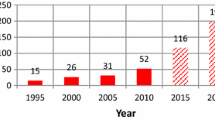Conclusions
-
1.
The current method of providing cavitation safety of spillways based on the assumption of a limited amount of erosion developing during a prescribed repair period requires creating an absolute scale of cavitation erosion resistance of protective lining materials.
-
2.
The traditionally used building materials (cement concrete, cement-sand mortars, wood, steel) and new building materials (latex concrete, polymer-sand mortars, polymer-concrete) make it possible to realize protective linings of spillways in various versions, and the spectrum of their cavitation erosion resistance can be selected in a quite wide range.
-
3.
Cavitation erosion resistance of protective lining materials is their specific, special property which does not correlate uniquely with other properties and, in particular, with the indices of strength and abrasion resistance.
Similar content being viewed by others
Literature cited
G. A. Vorob'ev, “Methods of assessing the conditions of use of building materials in an increased cavitation erosion resistance in hydraulic Structures,” Izv. VNIIG im. B. E. Vedeneeva,162, 62–68 (1983).
G. A. Vorob'ev, “Standardization of the requirements imposed on the surface quality and lining material of high-head spillways based on cavitation conditions with special reference to the Sayano-Shushenskoe overflow dam” Izv. VNIIG im. B. E. Vedeneeva,170, 103–110 (1983).
Methodological Recommendations on the Technology of Preparing Concrete Subjected to Cavitation and Erosion-Resistant Linings of Hydraulic Structures II-5-78 [in Russian], Énergiya, Leningrad (1972).
G. D. Petrov and R. E. Yazev, “Technology of using epoxy compositions for protecting concrete of hydraulic structures from cavitation erosion,” Gidrotekh. Stroit., No. 2 (1974).
G. A. Vorob'ev, B. V. Bedillo, and A. I. Komolov, “Cavitation erosion resistance of wood,” in: Collection of Scientific Papers of the Southern Scientific-Research Institute of Hydraulic Engineering and Reclamation [in Russian] (1983).
G. A. Vorob'ev, R. E. Yazev, T. M. Fraint, and V. G. Nikolaev, “Epoxy polymer-concrete as a material for protecting hydraulic structure from hydraulic abrasion,” Izv. VNIIG im. B. E. Vedeneeva,167, 47–51 (1983).
Additional information
Translated from Gidrotekhnicheskoe Stroitel'stvo, No. 6, pp. 18–20, June, 1985.
Rights and permissions
About this article
Cite this article
Vorob'ev, G.A. Standard cavitation erosion resistance of building materials. Hydrotechnical Construction 19, 280–284 (1985). https://doi.org/10.1007/BF02028558
Issue Date:
DOI: https://doi.org/10.1007/BF02028558




